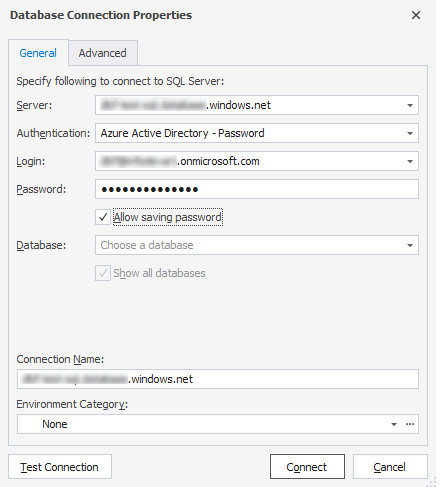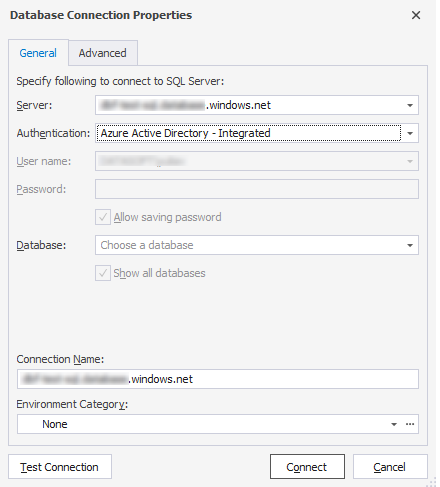Connect with Microsoft Entra ID authentication
If you have a Microsoft Entra instance configured, you can connect to an Azure database with a Microsoft Entra authentication in dbForge Studio for SQL Server.
Microsoft Entra ID is a Microsoft solution with a single or multi-factor authentication that ensures more secure access to the database.
In dbForge Studio for SQL Server, you can use the following authentication types of Microsoft Entra ID for connection:
- Microsoft Entra MFA
- Microsoft Entra Password
- Microsoft Entra Integrated
When connecting with the Microsoft Entra MFA authentication, dbForge Studio for SQL Server must be registered as a Microsoft Entra ID application. During the registration, an Application ID is generated, which you must provide to authenticate and connect to the Azure database using Microsoft Entra MFA. For instructions, see Register Studio for SQL Server as a Microsoft Entra ID application.
Open the Database Connection Properties dialog
To open the Database Connection Properties dialog, do one of the following:
-
On the Database menu, select New Connection.
-
On the Database Explorer toolbar, select
 New Connection.
New Connection. -
In Database Explorer, right-click any connection or empty space and select New Connection.
Microsoft Entra MFA
To connect with Microsoft Entra MFA:
1. On the General tab of the Database Connection Properties dialog, select Microsoft Entra MFA as an authentication type.
2. In the Server box, enter the URL of the Azure SQL Server instance.
3. In the User name box, enter a Microsoft Entra username with Azure SQL database permissions.
4. Next to Use common MFA options, select Change Common Options to open the Options dialog.

5. Enter Application ID and Redirect URL generated during the registration of dbForge Studio for SQL Server.
6. To save the changes, select OK.
Note
To use a different Application ID:
1. Select Override MFA options for this connection.
2. Enter the Application ID and Redirect URL.

6. To create a connection, select Connect.
7. In the Sign in to your account window that opens, enter the password for the specified Microsoft Entra ID account. After the successful login, you will gain access to the databases associated with the specified Azure SQL instance.
The Sign in to your account window also opens when you select Test Connection or try to choose a database in the Database box of the Database Connection Properties dialog.
Note
When creating a new connection to the same SQL Server on a different instance or in another standalone dbForge SQL tool, the Application ID and Redirect URL are automatically retrieved from the corresponding boxes in the Options dialog.
Microsoft Entra Password
To connect with Microsoft Entra Password:
1. On the General tab of the Database Connection Properties dialog, select Microsoft Entra Password as an authentication type.
2. In the Server box, enter the URL of the Azure SQL Server instance.
3. In the Login box, enter the Microsoft Entra ID username with Azure SQL database permissions.
4. In the Password box, enter the password for the specified user.
5. To create a connection, select Connect.

Microsoft Entra Integrated
To connect with Microsoft Entra Integrated:
1. On the General tab of the Database Connection Properties dialog, select Microsoft Entra Integrated as an authentication type.
2. In the Server box, enter the URL of the Azure SQL Server instance.
3. To create a connection, select Connect.

After a successful connection, the Database Connection Properties dialog is closed, and the connection along with its databases appears in Database Explorer.
If you first select Test Connection, the entered information is validated. After that, a pop-up window informing about a successful connection appears. Select Connect to create the connection and display it in Database Explorer.